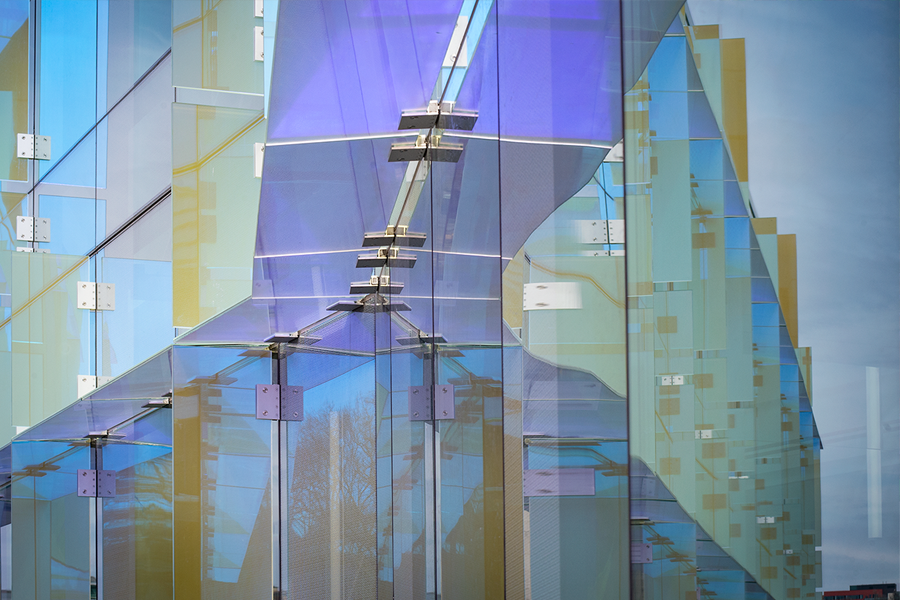
Growing the maker ecosystem and maker culture through the new Sherman and Joyce Scott Hall
Driving along Forbes Avenue towards Carnegie Mellon University’s campus now offers a new transformative view: the Sherman and Joyce Bowie Scott Hall, a building designed to be as visually stimulating as it will be essential to developing a true maker ecosystem in the College of Engineering and to interdisciplinary research initiatives at the university.
The College of Engineering has always had a maker culture of developing new and innovative tools and products that will enhance the modern world. However, researchers and students have been limited in the past when it comes to implementing these new ideas by the labs and technologies available to them on campus.
“Scott Hall will help us turn our maker culture into a maker ecosystem,” says James H. Garrett, Jr., Dean of the College of Engineering.
This maker ecosystem will affect not only the College of
The 109,000-square-foot Sherman and Joyce Bowie Scott Hall, designed by OFFICE 52 Architecture and set to open April 30, 2016, has two main sections: the North Wing and the Claire and John Bertucci Nanotechnology Laboratory, which meet at the Arthur C. Ruge Atrium and the Collaboratory, a four-story space that connects the levels of the North Wing of the building.
The North Wing is a multicolored glass structure that sits elegantly over Junction Hollow on a sculptural composition of angled white steel columns. These columns are strategically placed in the overall design to avoid the utilities below. The Bertucci Nanotechnology Lab is tucked between Porter, Hamerschlag, Roberts, and Wean Halls, turning what used to be a small service and parking area into a great deal of usable workspace.
The Bertucci Nanotechnology Lab is entered through a glass pavilion, and above the lab there is a green roof with skylights that extends the lawn of the Hornbostel Mall in front of Hamerschlag Hall, providing more space for work (and relaxation) both inside and outside of the building.
Inside the
The cleanroom, as well as other labs in the building, will provide researchers and students with easier access to cutting-edge technologies for making their theoretical, innovative ideas into actual products. It will enhance the college’s current capabilities and provide students and researchers with advanced ways to make products beyond what has been available in the past.
The Collaboratory and Ruge Atrium, which contain a café, are based on the idea that informal discussions are one of the main generators of collaborative work. These spaces are designed by the architects to facilitate these informal interactions taking place on a regular
Together, the three parts of the building directly connect the multiple disciplines within Scott Hall to four other buildings on campus and provide easy access to Baker Hall and Scaife Hall. This results in an important new nexus on campus for the College of Engineering and gives physical form to the collaborative culture of the college.
The building itself spans multiple disciplines, housing the Wilton E. Scott Institute for Energy Innovation, a program about shared research that has started a compelling new chapter for energy at CMU. It will also provide a new home for the Department of Biomedical Engineering, the Engineering Research Accelerator, the Disruptive Health Technologies Institute, and the nanotechnology research facility.
“The building will physically bring together hundreds of faculty and students from a variety of disciplines, allowing them to work together in ways they had not been able to before,” says Garrett.
Video: Design Architect Isaac Campbell discusses the design of Scott Hall
- The Wilton E. Scott Institute for Energy Innovation is named after Sherman Scott’s father. Both the Sherman and Joyce Bowie Scott Hall and the Wilton E. Scott Institute for Energy Innovation were funded by Sherman Scott and his wife Joyce Bowie Scott.
- John and Claire Ruge Bertucci funded the Bertucci Nanotechnology
Lab, and named the Ruge Atrium for Claire Bertucci’s father, Arthur C. Ruge, who was a Carnegie Tech alum. - Sherman and Joyce Bowie Scott are both alums who met while studying at Carnegie Mellon University—which is also true of John and Claire Ruge Bertucci.
- Joyce Bowie Scott, an alumna of the College of Fine Arts, is an artist at the J. Bowie Scott Studio. Several of her paintings will be hung in Scott Hall.
- Jonathan Rothberg, a Chemical Engineering graduate, and his family have a café in the building, Rothberg’s Roasters, which is the second café he has funded on campus.
- The cleanroom in Scott Hall was funded by the Eden Hall Foundation, while the Richard King Mellon Foundation supported both Scott Hall and the Scott Institute. The Swanson Family and other generous donors also made Scott Hall possible
.
Scott Hall has what architects call a “curtain wall”—meaning it has a lightweight, nonstructural outside covering that serves primarily to keep
In Scott Hall’s case, the curtain wall is made of glass, which has a special secret for those working in nanofabrication that